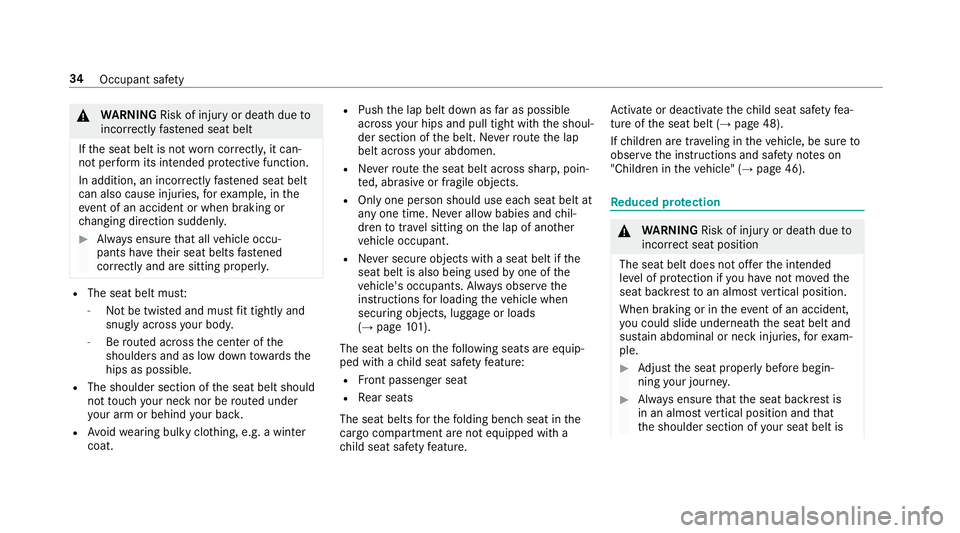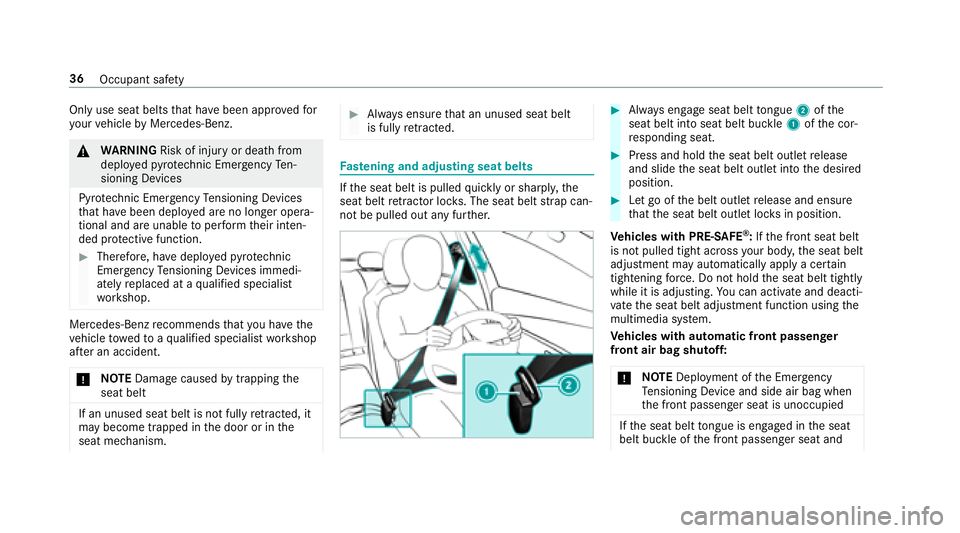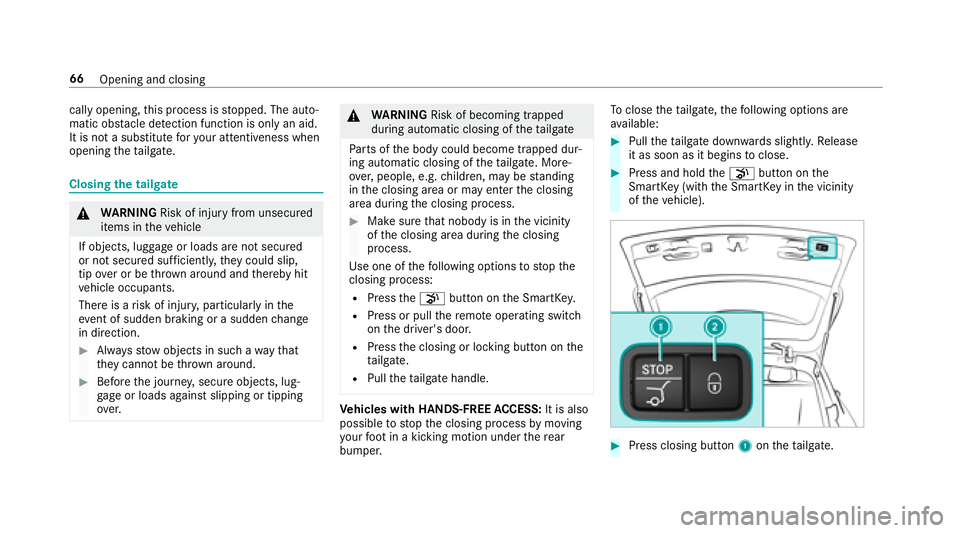2018 MERCEDES-BENZ E-CLASS WAGON tow
[x] Cancel search: towPage 36 of 506

&WARNING Risk of injury or death dueto
incor rectly fastened seat belt
If th e seat belt is not worncor rectly, it can‐
not per form its intended pr otective function.
In addition, an incor rectly fastened seat belt
can also cause injuries, forex ample, in the
ev ent of an accident or when braking or
ch anging direction suddenly .
#Always ensure that all vehicle occu‐
pants ha vetheir seat belts fastened
cor rectly and are sitting prope rly.
RThe seat belt mus t:
-Not be twisted and must fit tightly and
snugl yacross your body .
-Berouted across the center of the
shoulders and as low down towa rdsth e
hips as possible.
RThe shoulder section of the seat belt should
not touch your ne cknor be routed under
yo ur arm or behind your bac k.
RAvoid wearing bulky clo thing, e.g. a winter
coat.
RPush the lap belt down as far as possible
across your hips and pull tight withth e shoul‐
der section of the belt. Ne verro ute the lap
belt across your abdomen.
RNe verro ute the seat belt across sharp, poin‐
te d, abrasive or fragile objects.
ROnly one person should use each seat belt at
any one time. Ne ver all owbabies and chil‐
dren totrave l sitting on the lap of ano ther
ve hicle occupant.
RNe ver secure objects with a seat belt if the
seat belt is also being used byone of the
ve hicle's occupants. Alw ays obser vethe
instructions for loading theve hicle when
securing objects, luggage or loads
(
→page 101).
Th eseat belt son thefo llowing seats are equip‐
ped with a child seat saf etyfe ature:
RFr ont passenger seat
RRe ar seats
The seat belts forth efo lding bench seat in the
cargo compart ment are not equipped with a
ch ild seat saf etyfe ature. Ac
tivate or deacti vate thech ild seat saf etyfe a‐
t
ure of the seat belt (→page 48).
If ch ildren are tra veling in theve hicle, be sure to
obser vethe instructions and saf etyno tes on
"Children in theve hicle" (
→page 46).
Re duced pr otection
&
WARNING Risk of injury or death dueto
incor rect seat position
The seat belt does not of ferth e intended
le ve l of pr otection if you ha venot mo vedth e
seat backrest toan almost vertical position.
When braking or in theeve nt of an accident,
yo u could slide underneath the seat belt and
sus tain abdominal or neck injuries, forex am‐
ple.
#Ad just the seat proper lybefore begin‐
ning your journe y.
#Always ensure that the seat backrest is
in an almost vertical position and that
th e shoulder section of your seat belt is
34
Occupant saf ety
Page 38 of 506

Only use seat beltsthat ha vebeen appr ovedfo r
yo ur vehicle byMercedes-Benz.
&
WARNING Risk of injury or death from
deplo yedpy rotech nic Emergency Ten‐
sioning Devices
Pyro tech nic Emergency Tensioning Devices
th at ha vebeen deplo yed are no longer opera‐
tional and are unable toper form their inten‐
ded pr otective function.
#Therefore, ha vedeplo yedpy rotech nic
Emergency Tensioning Devices immedi‐
ately replaced at a qualified specialist
wo rkshop.
Mercedes-Benz recommends that you ha vethe
ve hicle towe dto aqu alified specialist workshop
af te r an accident.
* NO
TEDama gecaused bytrapping the
seat belt
If an unused seat belt is not fully retracted, it
may become trapped in the door or in the
seat mechanism.
#Alw ays ensure that an unused seat belt
is fully retracted.
Fa stening and adju sting seat belts
Ifth e seat belt is pulled quickly or sharpl y,the
seat belt retractor lo cks. The seat belt stra p can‐
not be pulled out any fur ther.
#Alw ays engage seat belt tongue 2ofthe
seat belt into seat belt buckle 1ofthe cor‐
re sponding seat.
#Press and hold the seat belt outlet release
and slide the seat belt outlet into the desired
position.
#Let go of the belt outlet release and ensure
th at the seat belt outlet loc ksin position.
Ve hicles with PRE-SAFE
®:If th e front seat belt
is not pulled tight across your body, the seat belt
adjustment may automatically apply a cer tain
tigh tening forc e. Do not hold the seat belt tightly
while it is adjusting. You can activate and deacti‐
va te the seat belt adjustment function using the
multimedia sy stem.
Ve hicles with automatic front passenge r
front air bag shu toff:
* NO
TEDeployment of the Emer gency
Te nsioning Device and side air bag when
th e front passenger seat is unoccupied
Ifth e seat belt tongue is engaged in the seat
belt buckle of the front passenger seat and
36
Occupant saf ety
Page 41 of 506

&WARNING Risk of injury or death dueto
incor rect seat position
If yo ude viate from the cor rect seat position,
th e air bag cannot perform its intended pro‐
te ctive function and deployment may even
cause fur ther injuries.
To avo id hazardous situations, alw ays make
sure that all vehicle occupants:
RHa ve their seat belt fastened cor rectly,
including pregnant women.
RAre seated properly and that dis tance to
th e air bags is as large as possible.
RObser vethefo llowing information.
#Alw ays make sure that there are no
objects between the air bag and the
ve hicle occupant.
To avo idrisks resulting from the deployment of
th e air bag:
RBefore starting your journe y,adjust your seat
co rrectly ;th e driver's seat and front
passenger seat should be mo ved as far back
as possible. When doing so, alw
ays obser vethe informa‐
tion on the cor rect driver's seat position
(
→page 82).
ROnly hold thesteering wheel bythesteering
wheel rim. This all owsth e air bag tobe fully
deplo yed.
RAlw ays lean against the seat backrest when
th eve hicle is in motion. Do not lean forw ards
or against the door or side windo w.You may
ot herwise be in the deployment area of the
air bags.
RAlw ayske ep your feet on thefloor. Do not
put your feet on the dashboard, forex ample.
Yo ur feet may otherwise be in the deploy‐
ment area of the air bag.
RIfch ildren are tra veling in theve hicle,
obser vethe additional no tes (→page 46).
RAlw aysstow and secure objects cor rectly. Objects in
theve hicle interior may pr event an air
bag from functioning cor rectly. There fore alw ays
ensure that:
RThere are no people, animals or objects
between theve hicle occupants and an air
bag.
RThere are no objects between the seat, door
and door pillar (B-pillar).
RThere are no hard objects, e.g. coat hangers,
hanging on the grab handles or coat hooks.
RThere are no accessory parts, such as cup
holders, attached totheve hicle within the
deployment area of an air bag, e.g. on doors,
side windo wsor side paneling.
RThere are no heavy, sharp-edged or fragile
objects in the poc kets of your clo thing. Store
such objects in a suitable place.
Occupant saf ety 39
Page 42 of 506

Reduced air bag pr otection
&
WARNING Risk of injury from modifica‐
tions tothe airbag co ver
If yo u modify an airbag co ver or af fix objects
such assticke rs to it,the airbag can no lon‐
ge r function cor rectl y.
#Ne ver modify an airbag co ver and do
not af fix objects toit.
The ins tallation location of an air bag is identi‐
fi ed bythe AIRB AGsymbol .
&
WARNING Risk of injury or death dueto
th e use of unsuitable seat co vers
Uns uitable seat co vers can obstruct or pre‐
ve nt the deployment of air bags integrated
into the seats.
Consequentl y,the air bags cannot protect
ve hicle occupants as they are designed to
do. In addition, operation of the automatic
front passenger air bag shutoff may be
re stricted.
#Yo u should only use seat covers that
ha ve been appr oved forth e cor respond‐
ing seats byMercedes-Benz.
&
WARNING Risk of injury duetomalfunc‐
tions of the sensors in the door paneling
Sensors tocontrol the airbags are located in
th e doors. Modifications or worknot per‐
fo rm ed cor rectly tothe doors or door panel‐
ing, as well as damaged doors, can lead to
th e function of the sensors being impaired.
The airbags might therefore not function
proper lyany more.
Consequent ly,th e airbags cannot protect
ve hicle occupants as they are designed to
do.
#Ne ver modify the doors or parts of the
doors.
#Alw ays ha vewo rkon the doors or door
paneling car ried out at a qualified spe‐
cialist workshop.
&
WARNING Risk of injury duetodeplo yed
airbag
A deplo yed airbag no longer has a pr otective
function and cann otprotect as intended in
th eev ent of an accident.
#Ha ve theve hicle towe dto aqu alified
specialist workshop in order tohave the
deplo yed airbag replaced.
Ha ve deplo yed air bags replaced immediately.
St atus of the front passenger airbag
Po ints toremember when the front
passen ger seat is occupied
The au tomatic front passenger air bag shutoff is
able todetect whe ther the front passenger seat
is occupied bya person or a child restra int sys‐
te m. The front passenger air bag is enabled or
disabled accordingly.
When ins talling a child restra int sy stem on the
front passenger seat:
REnsure that thech ild restra int sy stem is posi‐
tioned cor rectly (→page 46).
40
Occupant saf ety
Page 60 of 506

Deactivatethe KEYLESS-GO function of the
SmartK ey.
#To deactivate: pressthe& button on the
SmartK eytwice in rapid succession.
The battery check lamp of the SmartK ey
fl ashes twice brief lyand lights up once.
#To activate: press any button on the Smart‐
Ke y.
% When theve hicle is star ted with the Smart‐
Ke yin thestow age compartment of the cen‐
te r console (
→page 145),th e SmartK ey
functions are au tomatically activated.
Inserting/re moving the mechanical key
#To remo ve:press release knob 1.
Mechanical key2 is pushed out slight ly.
#Pull ou tme chanical key2 until it en gage s in
th e intermediate position.
% You can use the intermediate position of
mechanical key2 toattach the SmartK ey
to ake yring.
#Press release knob 1again and fully
re mo vemechanical key2.
#To inser t:press release knob 1.
#Insert mechanical key2 tothe intermediate
position or fully until it engages.
Re placing the SmartK eybattery
&
DANG ER Serious damage tohealth
caused byswallowing batteries
Batteries contain toxic and cor rosive sub‐
st ances. Swallowing batte ries may cause
serious damage tohealth.
There is a risk of fata l injur y.
#Keep batteries out of there ach of chil‐
dren.
#If batteries are swallo wed, seek medical
attention immediately.
+ENVIRONMEN TALNO TEEnvironmental
damage causedbyimproper disposal of
batteries
Bat teries conta in pollutants. It is
illegal todispose of them with the household
ru bbish.
#
Dispose of batteries in an
environmen tally responsible manner.
Ta ke dischar ged batteries toaqu alified
specialist workshop or toa collection
point for used batteries.
58
Opening and closing
Page 65 of 506

ProblemPossible causes/consequences and MSolutions
RThe SmartKeyis malfunctioning.
#Activate KEYLESS-GO .
#Check the battery using the battery check lamp and replace if necessary .
#Use the mechanical keyto lock or unlock theve hicle .
#Ha ve theve hicle and SmartK eychecked at a qualified specialist workshop.
Switching the automatic locking feature
on/off
The vehicle is loc ked automatically when the
ignition is switched on and the wheels are turn‐
ing fast erthan walking pace.
#To deactivate: press and hold button 1for
appr oximately five seconds until an acoustic
signal sounds.
#To activate: press and hold button 2for
appr oximately five seconds until an acoustic
signal sounds.
Danger of being loc ked out when the function is
activated:
RIf th eve hicle is being tow star ted/pushed.
ROn a roller dynamome ter.
Opening and closing 63
Page 68 of 506

cally opening,this process is stopped. The auto‐
matic obs tacle de tection function is only an aid.
It is not a substitute foryo ur attentiveness when
opening theta ilgate.
Closing the tailgate
&
WARNING Risk of injury from unsecured
items in theve hicle
If objects, luggage or loads are not secured
or not secured suf ficientl y,they could slip,
tip ove r or be throw n around and thereby hit
ve hicle occupants.
There is a risk of injur y,particularly in the
ev ent of sudden braking or a sudden change
in direction.
#Alw aysstow objects in such a wayth at
th ey cannot be thro wn around.
#Before the journe y,secure objects, lug‐
ga ge or loads against slipping or tipping
ove r.
&
WARNING Risk of becoming trapped
duri ng au tomatic closing of theta ilgate
Pa rts of the body could become trapped dur‐
ing automatic closing of theta ilgate. More‐
ove r,people, e.g. children, may be standing
in the closing area or may enter the closing
area during the closing process.
#Make sure that nobody is in the vicinity
of the closing area during the closing
process.
Use one of thefo llowing options tostop the
closing process:
RPress thep button on the SmartK ey.
RPress or pull there mo teoperating switch
on the driver's door.
RPress the closing or locking button on the
ta ilgate.
RPull theta ilgate handle.
Ve hicles with HANDS-FREE ACCESS: It is also
possible tostop the closing process bymoving
yo ur foot in a kicking motion under there ar
bumper. To
close theta ilgate, thefo llowing options are
av ailable:
#Pull theta ilgate down wards slightly. Release
it as soon as it begins toclose.
#Press and hold thep button on the
SmartK ey(with the SmartK eyinthe vicinity
of theve hicle).
#Press closing button 1ontheta ilgate.
66
Opening and closing
Page 70 of 506

HANDS-FREEACCESS function
With HANDS-FREE ACCESS you can open, close
or stop the closing process of theta ilgate by
per form ing a kicking mo vement under there ar
bumper.
The kicking mo vement triggers the opening or
closing process alternately. Obser
vethe no tes when opening (
→page 64)
and closing (→page 66) theta ilgate.
% Twowa rning tones sound when thetai lgate
is opening or closing.
& WARNING Risk of burn s causedbya hot
ex haust sy stem
The vehicle exhaust sy stem can become very
hot. If you use HANDS- FREEACCESS, you
could burn yourself by touching theex haust
sy stem.
#Alw ays ensure that you only ma kea
kicking mo vement within the de tection
ra nge of the sensors.
* NO
TEVehicle damage due tounin ten‐
tional opening of theta ilgate
Rwhen using an automatic car wash
Rwhen using a high pressure cleaner
#Deactivate KEYLESS-GO or make sure
that theke ylocated is at leas t10 ft
(3 m) away from theve hicle in such sit‐
uations.
When making the kicking mo vement, make sure
th at you are standing firm ly on the ground you
could otherwise lose your balance, e.g. on ice.
Re quirements:
RThe SmartK eyis behind theve hicle.
RStand at least 12in (30 cm) away from the
ve hicle while per form ing the kicking mo ve‐
ment.
RDo not come into contact with the bumper
while making the kicking mo vement.
RDo not car ryout the kicking mo vement too
slowl y.
RThe kicking mo vement must be towa rdsth e
ve hicle and bac k.
68
Opening and closing